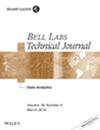下载PDF
{"title":"Current and Future Flexible Wavelength Routing Cross-Connects","authors":"Thierry Zami","doi":"10.1002/bltj.21626","DOIUrl":null,"url":null,"abstract":"<p>Existing and evolving telecommunication services rely upon transport infrastructure for their carriage, including that provided by wavelength division multiplexing (WDM) based networking. In order to maximize reach in the photonic domain, thus limiting the total number of costly and power-greedy optoelectronic regenerators required for reliable transport, optimization of wavelength routing cross-connect (WRXC) properties is essential. There are several relevant WRXC properties. These include low physical impact on optical channels, enabling usage of advanced modulation formats with high spectral efficiency, support for flexible wavelength allocation as well as multi-directional, colorless, and contentionless insertion/extraction of traffic, resilience against failures, and automatic lightpath setup. Other factors supporting WRXC deployment involve fair initial cost, compactness and modularity, and scalability to high connectivity and to significant add/drop capacity. Some of these features are a “must have” whereas others are a “nice to have.” This paper reviews the primary trends affecting current and future WRXC evolution considering these functionalities as well as the corresponding tradeoffs. ©2013 Alcatel-Lucent.</p>","PeriodicalId":55592,"journal":{"name":"Bell Labs Technical Journal","volume":"18 3","pages":"23-38"},"PeriodicalIF":0.0000,"publicationDate":"2013-11-27","publicationTypes":"Journal Article","fieldsOfStudy":null,"isOpenAccess":false,"openAccessPdf":"https://sci-hub-pdf.com/10.1002/bltj.21626","citationCount":"12","resultStr":null,"platform":"Semanticscholar","paperid":null,"PeriodicalName":"Bell Labs Technical Journal","FirstCategoryId":"1085","ListUrlMain":"https://onlinelibrary.wiley.com/doi/10.1002/bltj.21626","RegionNum":0,"RegionCategory":null,"ArticlePicture":[],"TitleCN":null,"AbstractTextCN":null,"PMCID":null,"EPubDate":"","PubModel":"","JCR":"Q1","JCRName":"Engineering","Score":null,"Total":0}
引用次数: 12
引用
批量引用
Abstract
Existing and evolving telecommunication services rely upon transport infrastructure for their carriage, including that provided by wavelength division multiplexing (WDM) based networking. In order to maximize reach in the photonic domain, thus limiting the total number of costly and power-greedy optoelectronic regenerators required for reliable transport, optimization of wavelength routing cross-connect (WRXC) properties is essential. There are several relevant WRXC properties. These include low physical impact on optical channels, enabling usage of advanced modulation formats with high spectral efficiency, support for flexible wavelength allocation as well as multi-directional, colorless, and contentionless insertion/extraction of traffic, resilience against failures, and automatic lightpath setup. Other factors supporting WRXC deployment involve fair initial cost, compactness and modularity, and scalability to high connectivity and to significant add/drop capacity. Some of these features are a “must have” whereas others are a “nice to have.” This paper reviews the primary trends affecting current and future WRXC evolution considering these functionalities as well as the corresponding tradeoffs. ©2013 Alcatel-Lucent.
当前和未来的柔性波长路由交叉连接
现有和发展中的电信业务依赖于传输基础设施,包括基于波分复用(WDM)的网络提供的传输基础设施。为了最大限度地达到光子域,从而限制可靠传输所需的昂贵且功耗高的光电再生器的总数,波长路由交叉连接(WRXC)特性的优化是必不可少的。有几个相关的WRXC属性。其中包括对光通道的低物理影响,支持使用具有高频谱效率的高级调制格式,支持灵活的波长分配以及多向、无色和无争议的流量插入/提取,抗故障的弹性以及自动光路设置。支持WRXC部署的其他因素包括合理的初始成本、紧凑性和模块化,以及高连接性和显著的添加/删除容量的可扩展性。其中一些功能是“必须具备的”,而另一些则是“最好拥有”。本文回顾了影响当前和未来WRXC发展的主要趋势,并考虑了这些功能以及相应的权衡。©2013年阿尔卡特-朗讯(alcatel - lucent)。
本文章由计算机程序翻译,如有差异,请以英文原文为准。

 求助内容:
求助内容: 应助结果提醒方式:
应助结果提醒方式:


